Pavis – Gateway to Adventure: The Classic RPG City is Back! (Part Two)
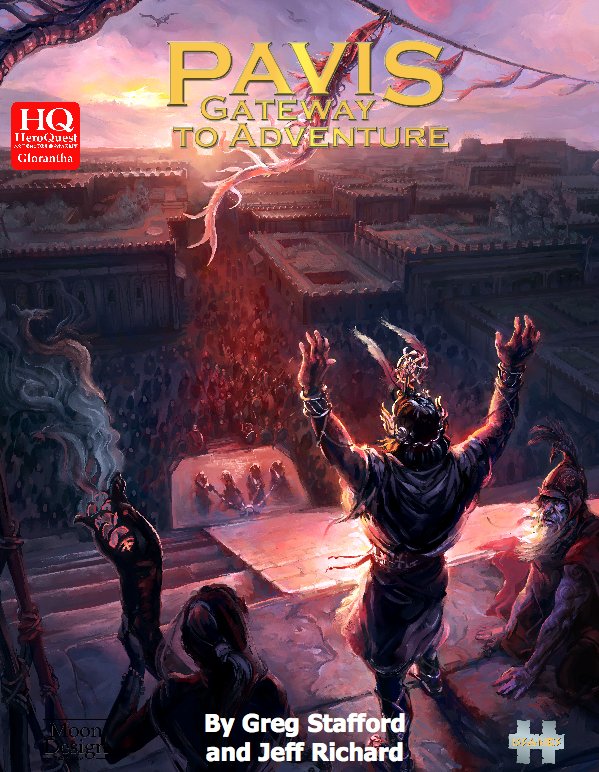 Last week I began my review of Pavis – Gateway to Adventure, the new RPG supplement from Moon Design Publications for its HeroQuest roleplaying game in the fantasy world of Glorantha, with a bit of history of this greatest of RPG cities, and an overview of what this massive new book contains. This week, I’d like to look at the book’s content in far more detail, with a chapter-by-chapter breakdown of just what you get in its 416 pages.
Last week I began my review of Pavis – Gateway to Adventure, the new RPG supplement from Moon Design Publications for its HeroQuest roleplaying game in the fantasy world of Glorantha, with a bit of history of this greatest of RPG cities, and an overview of what this massive new book contains. This week, I’d like to look at the book’s content in far more detail, with a chapter-by-chapter breakdown of just what you get in its 416 pages.
Chapter by Chapter
To begin with, the book’s cover is a nice full colour painting depicting a priest of the cult of Pavis, the city god, atop the ziggurat-like temple of Pavis in the new city, facing east over assembled city-folk and worshippers as the sun rises. In contrast to the green and earth tones of the previous two Sartar books, the cover is predominantly pinks, purples, and greys, emphasizing the hazy, desert-like environment of the city. It gives a feel for the predominance of religion – and religious intrigue – in the city.
After credits, contents, and introduction sections, the book launches straight into “Making Your Character”. If you have Sartar: Kingdom of Heroes, you’ll know what to expect here; except that in addition to the Sartarite settlers of Pavis County, there are also HeroQuest keywords and character creation guidelines for Old Pavisites, Sun Domers, Zola Fel Riverfolk, and even Lunar Settlers.
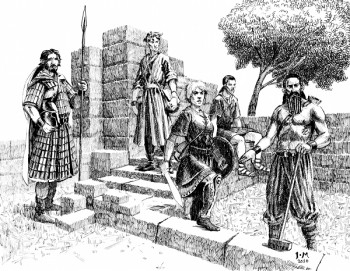
There’s some lovely character artwork here, including some published in previous supplements, but most of this material I don’t think I’ve seen before. Like Sartar: Kingdom of Heroes, sample characters are provided, all of which are interesting examples of the types of characters Pavis throws up; and there’s a new character sheet. Personally I don’t like it as much as the one in Sartar: Kingdom of Heroes – it’s a little too bare bones for me, but it provides a good neutral sheet for some possibly very different characters. The character creation section then finishes with some modifications to the Clan Creation guidelines in Sartar: Kingdom of Heroes, detailing what you need to do if you’re creating a Pavis clan. Some excellent material here, tying your clan and therefore your character background tightly into the city’s recent history.
This section is then followed by essays on the history of the city of Old Pavis – now the Big Rubble – including schematic maps of key stages in the city’s history, as well as a wonderful illustration of the “Faceless Statue” which the hero Pavis rode into the ancient city (now the Big Rubble) at its creation, and which was dismembered to make the old city’s buildings and monuments.
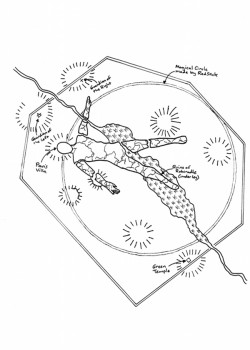
From that point, the book zooms out into “wild” Prax – the great desert wasteland surrounding Pavis and the Big Rubble. This is a great overview – it’s from the point of view of Pavisites and Sartarite adventurers, rather than Prax’s native inhabitants, but it’s exactly what you need in the context of the book. There are descriptions of the nomad tribes (including my favourite, the Agimori, or Men-and-a-Half); an overview of Praxian animist religious practices (enough for the narrator to satisfactorily represent Praxian NPCs and adversaries); and a gazetteer of the key Praxian locations.
There’s then a flipside section which focuses on the more civilized side of Prax – including the valley of the River of Cradles; the port of Corflu; the Lunar Grantlands; the lands of the Sun Dome (the cult of Yelmalio); and Pavis County, the lands immediately around the city. Again these detail the inhabitants and key locations, with plenty of maps and cool textboxes and adventure hooks.
There then follows a superb section on “Praxian Encounters”. If you’ve seen the Sartar Encounters in the Sartar Companion, you’ll know what to expect. This is a kind of geographical and meteorological overview, cum encounter tables, cum bestiary, and provides oodles of playable detail on adversaries such as baboons, magisaurs, cliff toads, nomads, and much more. There are 37 encounters and 2 special encounters in this section, each of which can easily become the focus of an entire adventuring session in its own right.
I loved this section in the Sartar Companion, and I love it here too – all the more so because there’s actually another encounters section, focusing on encounters within the city of Pavis, later on in the book. This is loads of instantly playable material – and, as per HeroQuest, largely stat free, which means it’s easily redeployable for other game systems, or just a cracking read.
After this extensive section on Prax, some 150 pages in, we finally get to the city itself, with a huge section on New Pavis, including: descriptions of the city and its atmosphere; buildings, population breakdowns, census details; politics (including piles of NPCs); information on the Lunar occupation forces, including several Lunar regiments (either for the player characters or as adversaries – I know which one I’m picking!); and an extensive chapter on cults. There’s then a section on the “City of Thieves”, featuring street gangs and other lowlives of the city’s less salubrious parts, again with plenty of NPC write-ups and filled with scenario hooks and ideas for more urban adventures. Pavis is a great city to plan a heist!
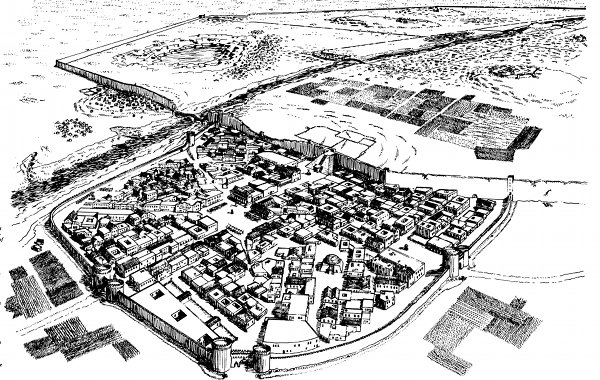
There’s then one of my favorite chapters, called “Living in Pavis.” I don’t know what it is about this relatively crunchy chapter, detailing the various inns, taverns, shops, equipment suppliers, trainers, specialists, etc, of the city, but for me it positively reeks with that awesome Pavis flavor.
Most importantly – and perhaps surprisingly, for a game like HeroQuest – the chapter also deals with handling money in your game. HeroQuest, like most storytelling-type roleplaying games, de-emphasises money-grubbing in favour of a more abstract, heroic “wealth” system; this chapter provides guidelines for how to deal with coins, treasure, and the pursuit of actual physical riches in your game.
Prices are given for items of equipment, provisions, food and drink, plus descriptions of specific items of equipment and treasure. Want a linothorax cuirass? There’s a description here, as well as a price (it runs from 10 to 30 silver Lunars, depending on how many plates it’s got…). The chapter even includes land values, and what you can get for working as a mercenary.

This chapter probably marks one of the biggest differences in tone from the previous Sartar books. Pavis is a city of extreme wealth inequality; of thieves, Rubble bandits, and adventurers raiding ancient ruins looking for loot and treasure. Coins and the pursuit of wealth are a key part of the setting – unlike Sartar’s more clan-oriented style of play – and this chapter provides you with everything you need to really focus on gear, equipment, and money, and get haggling in the market like a true Pavisite!
The section is then followed by a chapter on the “Neighbourhoods of New Pavis”. These are basically the street maps – detailed maps of every single building in every neighborhood of the city, together with keyed descriptions of pretty much every significant building, from shops to residences, inns to temples, flophouses to government buildings. If you own the old 1980s Pavis boxed set, you’ll recognize a lot of the material here. If you want a sandbox adventure of simply walking around this hot and dusty city and seeing what trouble you can stir up, this chapter is a gem.
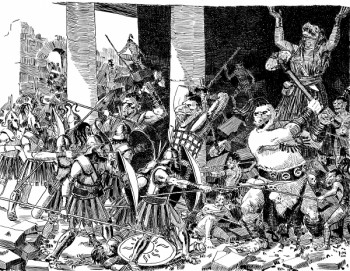
We’re now 230 pages in – over half way at last! (I told you this was a big book.) Now come the city encounter chapters – 31 encounters you can have just simply walking through the city (maybe sandboxing the maps in the previous chapter); then 20 “special encounters”, which are really campaign events or mini-adventures in their own right, ranging from drought, to nomad raids, to outbreaks of plague and riots. Again, there is oceans of playing material here, and a rollicking good read!
We’re almost at the end of the pure content material, now. On page 272 there’s a chapter on the Big Rubble, the Cyclopean ruins which constitute the lethal neighbour of the new city. It’s a short chapter – just an overview, plus a cool picture map by Gillian Pearce (if you’ve seen her stuff in the other Sartar books, you’ll now the sort of thing – it’s great). Like the Pavis and Big Rubble boxed sets of the 1980s, Moon Design are intending to release a subsequent volume after Pavis – Gateway to Adventure, to be called Big Rubble – The Deadly City, which will treat those adventure-filled ruins in the same lavish detail as this tome has the new city. For now, this chapter provides a tantalizing glimpse of New Pavis’ enormous neighbour, including the wonderful “Adventurers’ Licenses” which graced the first boxed set. Yup – if you’re going adventuring in the Big Rubble, you’d better make sure you’re registered with the Lunar authorities at the gates, or your hard-won loot will be subject to confiscation on your return. Damned Lunar bureaucracy gets everywhere!
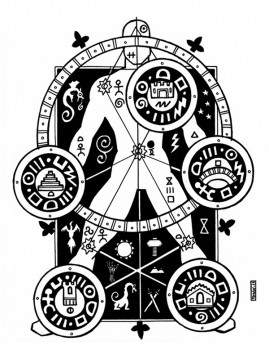
There now follows almost a hundred pages of adventures set in and around the city of New Pavis, all taking place in the rough campaign timeline assumed by the book (in Gloranthan terms, that’s the years 1618 to 1620, so a little later than the Sartar books, but they overlap neatly so you can travel back and forth if you need to. Or if you get exiled, say…). There are four adventures here: I won’t go into detail for spoilers, but suffice it to say they’re all of the same great quality as those in the previous two Sartar books, and feature some awesome colour artwork and truly excellent Gloranthan lore, including some very surprising heroquesting… For Gloranthan aficionados, I’ll just wink and say “God Learners” and “Masks”. Say no more…
The final section of Pavis – Gateway to Adventure is taken up with cult descriptions specific to the city. They’re in the same format as those in the Sartar supplements; designed for use with HeroQuest, but with oodles of information for use with other systems if you prefer. They are the cults of: Pavis (including some great information on sorcerous grimoires); Flintnail; Lanbril; Yelmalio; Zola Fel; and the Lunar Cult of the Seven Mothers. This last one for me was very exciting; it provides details of Lunar magic, certainly sufficient to narrate NPCs and adversaries, and even to play Lunar PCs belonging to the Seven Mothers religion. It was something I felt I frequently wanted when playing the previous Sartar books, and now it’s here, in glorious detail and with some excellent background, most of which I’ve never seen published before.
The book then winds up with an index of places, and a more general subject index.
In Summary…
So that’s Pavis, re-imagined and re-published for the 21st century! It’s an amazing accomplishment – quite simply the best city supplement I’ve ever seen for a roleplaying game. It’s so ambitious it’s breathtaking; the scope, depth, and detail which Greg Stafford and Jeff Richard have provided here have set the bar again for roleplaying city supplements; this single book alone easily contains enough content to fit two separate RPG supplements of normal size, and is easily worth the price. Some of the material here has seen the light of day before in other forms; but most of it is new, and I’d heartily recommend it to anyone interested in roleplaying in Pavis, using either HeroQuest or any other system; or interested in roleplaying cities in general; or just looking for inspiration or a cracking read on fantasy city, culture and worldbuilding.
Come to Pavis! I’ll be drinking Cradle Wine in Gimpy’s – I’ve a room upstairs. And if you see Griselda, tell her Shaira says hi, and that dead trollkin is nothing to do with me…
Pavis – Gateway to Adventure is a 416-page paperback supplement for the Glorantha setting and HeroQuest game, price $59.99 from Moon Design Publications.
Sarah Newton is a writer of RPGs and genre fiction. The first part of her review of Pavis – Gateway to Adventure can be found here.
[…] Pavis – Gateway to Adventure is a 416-page paperback supplement for the Glorantha setting and HeroQuest game, price $59.99 from Moon Design Publications. Sarah Newton is a writer of RPGs and genre fiction. The second part of her review of Pavis – Gateway to Adventure can be found here. […]
[…] a classic urban setting, Pavis – Gateway to Adventure: The Classic RPG City is Back! (parts One and Two) was one of the most popular gaming articles we’ve published on the website this […]
[…] Pavis Review part 2 – Black Gate Magazine […]